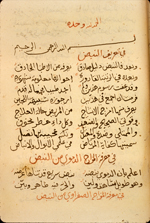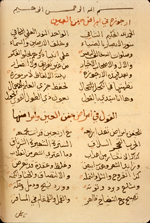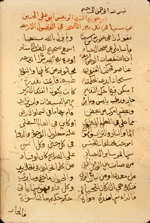Catalogue: Medical Poetry
-
 Urjūzah fī ta‘rīf al-nabḍ wa-al-bawl
(MS A 34, item 2)
Urjūzah fī ta‘rīf al-nabḍ wa-al-bawl
(MS A 34, item 2) - (A Poem on the Knowledge of the Pulse and Urine)
- ارجزة فى تعريف النبض والبول
- attributed to Abū ‘Alī al-Ḥusayn ibn ‘Abd Allāh Ibn Sīnā (Avicenna) (d. 1037/428)
- ابو على الحسين ابن عبد الله ابن سينا
This is a short didactic poem on detecting features of the pulse and urine that are useful in medical prognostics. In the copy at NLM it is attributed to Ibn Sīnā in a table of contents for the volume that was written on the first leaf. The attribution does not occur within the poem itself, however.
The poem is identical to that found in a collection of medical poetry now at the Wellcome Library for the History and Understanding of Medicine, London, where it also follows immediately upon a copy of the (first half of) Urjūzah fī al-ṭibb (Poem on Medicine) written by Ibn Sīnā, as it does in the NLM copy. The Wellcome copy, Arabic MS 129, fols. 24a-28a, is undated, possibly 17th-18th century; see Iskandar, "Wellcome", pp. 217-218. Like the NLM copy, however, the poem in the Wellcome copy does not explicitly state that it was written by Ibn Sīnā, and this poem has not been included amongst the works of Ibn Sīnā in the various bibliographical studies of Ibn Sīnā's compositions. No other copies are recorded.
Urjūzah fī ta‘rīf al-nabḍ wa-al-bawl (MS A 34 item 2)
Illustrations
The beginning of a poem on pulse and urine, attributed to Ibn Sīnā (Avicenna). Undated copy, possibly 18th century.
Physical Description
Arabic. 5 leaves (fols. 48a-52b). Dimensions 20 x 13.7 (text area approx 15.3 x 9) cm; 18 lines per page. The title is taken from the headings in the poem. The author is given as al-Shaykh al-Ra’īs Ibn Sīnā on the title page (fol. 1a) in a list of the contents of the volume, which is a collection of medical poetry.
The copy is undated; the general appearance of the script, ink, and paper suggests an 18th-century date. The same scribe copied the two following poems attributed to Ibn Sīnā.
A complete copy. The text is written in a medium-small naskh, inelegant and awkward but consistent, with some ligatures. The text area has been frame-ruled but the ruling was often not followed. Black ink with the headings in red and some vocalization; the ends of stanzas are indicated by red dots. There are catchwords and scattered marginalia.
-
 Urjūzah fī amrāḍ jafn al-‘ayn
(MS A 34, item 3)
Urjūzah fī amrāḍ jafn al-‘ayn
(MS A 34, item 3) - (A Poem on Diseases of the Eyelid)
- ارجوزة فى امراض جفن العين
- attributed to Abū ‘Alī al-Ḥusayn ibn ‘Abd Allāh Ibn Sīnā (Avicenna) (d. 1037/428)
- ابو على الحسين ابن عبد الله ابن سينا
This is a short didactic poem covering many diseases of the eye and not just those of the eyelids. In the NLM copy the author is actually not specified. In the manuscript, the poem occurs just after the poem described above on pulse and urine, which is usually attributed to Ibn Sīnā (Avicenna) and which in turn followed upon a copy of the famous Poem on Medicine (Urjūzah fī al-ṭibb) (MS A 34, item 1) by Ibn Sīnā. Moreover, this poem on eye diseases immediately precedes a poem on the management of health, described below, which is generally accepted as a genuine poem by Ibn Sīnā. It is likely, therefore, that this poem on ocular complaints was also considered to be a composition of Ibn Sīnā's.
The poem is identical to that found in a collection of medical poetry now at the Wellcome Library for the History and Understanding of Medicine, London, and in a nearly identical collection in the Vatican. In the Wellcome copy (Arabic MS 129, fols. 28a-30a) it also follows the poem on pulse and urine, which in turn follows a copy of the (first half of) Urjūzah fī al-ṭibb (Poem on Medicine) written by Ibn Sīnā, and it precedes the poem on the management of health by Ibn Sīnā, just as it does in the NLM copy. In the Vatican copy (MS Borg. arab. 87, fols. 27a-28a) the poem occurs in the same sequence, but the preceding poem on pulse and urine is in fact different from the one in the NLM and Wellcome manuscripts. Both the Vatican and Wellcome manuscripts are undated and appear to be of the 17th or 18th centuries; see Iskandar, "Wellcome", p. 224, and G. Levi della Vida, Elenco dei manuscritti arabi islamici della Biblioteca Vaticana, Vaticani Barberiniani Borgiani Rossiani, Studi e Testi 67 (Vatican City, 1935), p. 255.
In all three copies, that of NLM, the Vatican, and the Wellcome, it is not explicitly stated that the poem was written by Ibn Sīnā, and this poem has not been included amongst the works of Ibn Sīnā in the various bibliographical studies of Ibn Sīnā's compositions. No other copies are recorded.
Urjūzah fī amrā (MS A 34, item 3)
Illustrations
The beginning of a poem on diseases of the eye, possibly attributable to Ibn Sīnā (Avicenna). Undated copy, possibly 18th century.
Physical Description
Arabic. 3 leaves (fols. 52b-54a). Dimensions 20 x 13.7 (text area approx 15.3 x 9) cm; 18 lines per page. The title is given on fol. 52b, line 2. No author is given. The poem occurs amongst other poems attributed to al-Shaykh al-Ra’īs Ibn Sīnā.
The copy is undated; the general appearance of the script, ink, and paper suggests an 18th-century date. The same scribe copied all the items in the volume, including the previous poem attributed to Ibn Sīnā, and the following poem.
A complete copy. The text is written in a medium-small naskh, inelegant and awkward but consistent, with some ligatures. The text area has been frame-ruled but the ruling was often not followed. Black ink with the headings in red and some vocalization; the ends of stanzas are indicated by red dots. There are catchwords.
There are scattered marginalia.
-
 Urjūzah fī tadbīr al-ṣiḥḥah fī al-fuṣīl al-arba‘ah (MS A 34, item 4)
Urjūzah fī tadbīr al-ṣiḥḥah fī al-fuṣīl al-arba‘ah (MS A 34, item 4) - (Poem on the Regimen of Health in the Four Seasons)
- ارجوزة فى تدبير الصحة فى الفصول الاربعة
- by Abū ‘Alī al-Ḥusayn ibn ‘Abd Allāh Ibn Sīnā (Avicenna) (d. 1037/428)
- ابو على الحسين ابن عبد الله ابن سينا
This poem by Ibn Sīnā on regimen and the management of health through the changing seasons circulated under several titles. The most frequent title is that given in the NLM copy: Urjūzah fī tadbīr al-ṣiḥḥah fī al-fuṣīl al-arba‘ah. Others include urjūzah fī al-fuṣīl al-arba‘ah (poem on the four seasons), urjūzah fī al-fuṣīl al-arba‘ah al-da'ir fī al-sanah, (poem on the four seasons progressing through the year). Some versions include a few more lines (usually 9) than in the NLM copy.
The treatise has been edited by M. al-Baba in his Min mu'alafat Ibn Sīnā al-tibbiyat (Aleppo: Ma‘had al-turath al-‘ilmi al-‘arabi, 1984), pp. 195-206. It has been edited using the title Urjūzah mansub ilá Ibn Sīnā fī tadbīr al-ṣiḥḥah.
For other manuscript copies, see G. C. Anawati, Mu'allafat Ibn Sīnā: Essai de bibliographie Avicennienne (Cairo: Dar al-Ma‘arif, 1950), pp. 176 entry no. 115; Iskandar, "Wellcome", pp. 208-9; G. Levi della Vida, Elenco dei manuscritti arabi islamici della Biblioteca Vaticana, Vaticani Barberiniani Borgiani Rossiani, Studi e Testi 67 (Vatican City, 1935), p. 255; and GAL vol. 1, p. 458 (599) no. 88 and GAL-S vol. 1, p. 827 no. 91.
Urjūzah fī tadbīr al-ṣiḥḥah fī al-fuṣīl al-arba‘ah (MS A 34, item 4)
Illustrations
The beginning of a poem on regimen and the management of health through the changing seasons composed by Ibn Sīnā (Avicenna). Undated copy, possibly 18th century.
Physical Description
Arabic. 5 leaves (fols. 54b-58a). Dimensions 20 x 13.7 (text area approx 15.3 x 9) cm; 18 lines per page. The title is given on fol. 55b, line 2. The author is given as al-Shaykh al-Ra'is Abū ‘Alī al-Ḥusayn Ibn Sīnā on ol. 54b lines 2-3.
The copy is undated; the general appearance of the script, ink, and paper suggests an 18th-century date. The same scribe copied all the items in the volume.
A complete copy. The text is written in a medium-small naskh, inelegant and awkward but consistent, with some ligatures. The text area has been frame-ruled but the ruling was often not followed. Black ink with the headings in red and some vocalization; the ends of stanzas are indicated by red dots. There are catchwords.
There are scattered marginalia.
All three of these poems attributed to Ibn Sīnā were copied by the same copyist in one album of medical poetry.
The cream, semi-glossy paper has laid lines, single chain lines, and is watermarked; it is wormeaten (some repairs), and the edges have been trimmed from their original size.
The volume consists of 60 leaves and contains eight items of medical poetry, all transcribed by the same copyist. Item 1 (fols. 1a-47b) is the famous Urjūzah by Ibn Sīnā (MS A 34, item 1); items 2, 3, and 4 are the three medical poems attributed to Ibn Sīnā here described; item 5 (fols. 58b-59a) (MS A 34, item 5), item 6 (fol. 59a) (MS A 34, item 6), and item 7 (fols. 59b-60a) are three medical poems by Ibn Makkī (MS A 34, item 7); and item 8 (fol. 60b) is a fragment of a versification, often attributed to Ibn Sīnā, of a pseudo-Hippocratic treatise on prognostics (MS A 34, item 8). The table of contents on fol. 1a indicates that at one time these poems were bound together with a poem on anatomy by Ibn Sīnā and a treatise on bloodletting by Ibn Tilmīdh.
The contents and order of MS A 34 follow very closely that of a manuscript in London at the Wellcome Library for the History and Understanding of Medicine, MS Arab. 129, which is also undated and probably of the 17th-18th century, as well as an undated 17th-century manuscript in the Vatican, Borg. arab. 87. The Wellcome manuscript contains all the poems in the same sequence that are in the NLM manuscript, plus the poem on anatomy by Ibn Sīnā as well as the treatise by Ibn Tilmīdh. The Vatican manuscript has the poem on anatomy by Ibn Sīnā and all the poems in the NLM copy with one exception: the second item in the Vatican manuscript is a poem on pulse and urine, as in the NLM manuscript, but it is a different poem from that found in either the NLM or the Wellcome manuscripts.
Binding
The binding is red leather over pasteboards, with envelope flap; a modern library binding. The endpapers and pastedowns are modern.
Provenance
Purchased in 1941 by the Army Medical Library from A. S. Yahuda (ELS 1709 Med. 70).
References
Schullian/Sommer, Cat. of incun. & MSS., p. 304-305, A 34.
NLM Microfilm Reel: FILM 48-119 no. 1 .













